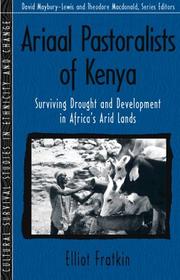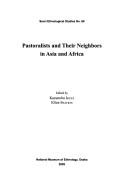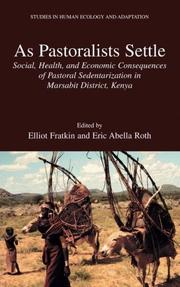| Listing 1 - 8 of 8 |
Sort by
|

ISBN: 0205269974 Year: 1998 Publisher: Boston Allyn and Bacon
Abstract | Keywords | Export | Availability | Bookmark
 Loading...
Loading...Choose an application
- Reference Manager
- EndNote
- RefWorks (Direct export to RefWorks)
Ariaal (African people) --- Arid regions agriculture --- Herders --- Pastoral systems --- Agriculture --- Domestic animals --- Social conditions --- Kenya --- Economic conditions
Book
Abstract | Keywords | Export | Availability | Bookmark
 Loading...
Loading...Choose an application
- Reference Manager
- EndNote
- RefWorks (Direct export to RefWorks)
Pastoral systems --- Herders --- Asia --- Africa, Eastern --- Rural conditions.

ISBN: 4901906348 Year: 2005 Publisher: Osaka National museum of ethnology
Abstract | Keywords | Export | Availability | Bookmark
 Loading...
Loading...Choose an application
- Reference Manager
- EndNote
- RefWorks (Direct export to RefWorks)
Herders --- Pastoral systems --- Africa, Eastern --- Asia --- Rural conditions.
Digital
ISBN: 9780306485954 Year: 2005 Publisher: Boston, MA Kluwer Academic / Plenum Publishers, New York
Abstract | Keywords | Export | Availability | Bookmark
 Loading...
Loading...Choose an application
- Reference Manager
- EndNote
- RefWorks (Direct export to RefWorks)

ISBN: 1280312947 9786610312948 0306485958 030648594X 1441934626 Year: 2005 Publisher: New York Kluwer Academic
Abstract | Keywords | Export | Availability | Bookmark
 Loading...
Loading...Choose an application
- Reference Manager
- EndNote
- RefWorks (Direct export to RefWorks)
The Social, Health, and Economic Consequences of Pastoral Sedentarization in Marsabit District, Northern Kenya ERICABELLA ROTH AND ELLIOT FRATKIN 1. INTRODUCTION Formerly nomadic livestock-keeping pastoralists have settled in many regions of the world in the past century. Some groups, including those in the former Soviet Union, Iran, and Israel, have settled in response to state-enforced measures; others including Saami in Norway or Bedouins in Saudi Arabia, in response to changing economic opportunities. East Africa, home to many cattle- and camel-keeping pastoral societies, has been among the most recent to change. The shift to sedentism by East African pastoralists increased d- matically in the late 20th century as a result of sharp economic, political, demographic, and environmental changes. Prolonged drought, population growth, increased reliance on ag- culture, and political insecurities including civil war and ethnic conflict have all affected the ability of pastoralists to keep their herds. Still, the majority of pastoralist households in Kenya, Ethiopia, Somalia, and Tanzania remain committed to raising livestock, even as they adapt to farming or urban residence. Pastoral production remains a major economic focus in the savannas and scrub deserts of Africa, due to both its ecological adaptability and the economic incentive to market livestock and their products (Fratkin, 2001). Pastoralists settle for a variety of reasons, some in response to ‘pushes’away from the pastoral economy, others to the ‘pulls’of urban or agricultural life.
Nomads --- Sedentarisation. --- Marsabit District (Kenya) --- Economic conditions. --- Social conditions. --- Nomadic peoples --- Nomadism --- Pastoral peoples --- Vagabonds --- Wanderers --- Persons --- Herders --- Anthropology. --- Population. --- Environmental management. --- Population Economics. --- Environmental Management. --- Public Health. --- Environmental stewardship --- Stewardship, Environmental --- Environmental sciences --- Management --- Human population --- Human populations --- Population growth --- Populations, Human --- Economics --- Human ecology --- Sociology --- Demography --- Malthusianism --- Human beings --- #SBIB:39A4 --- #SBIB:39A73 --- Sedentarization --- Toegepaste antropologie --- Etnografie: Afrika --- Public health. --- Community health --- Health services --- Hygiene, Public --- Hygiene, Social --- Public health services --- Public hygiene --- Social hygiene --- Health --- Human services --- Biosecurity --- Health literacy --- Medicine, Preventive --- National health services --- Sanitation --- Primitive societies --- Social sciences
Book
ISBN: 1555873227 9781555873226 Year: 1994 Publisher: Boulder Rienner
Abstract | Keywords | Export | Availability | Bookmark
 Loading...
Loading...Choose an application
- Reference Manager
- EndNote
- RefWorks (Direct export to RefWorks)
#SBIB:39A73 --- #SBIB:39A11 --- Pastoral systems --- -Nomads --- -Human ecology --- -Ecology --- Environment, Human --- Human beings --- Human environment --- Ecology --- Ecological engineering --- Human geography --- Nature --- Nomadic peoples --- Nomadism --- Pastoral peoples --- Vagabonds --- Wanderers --- Persons --- Herders --- Herding systems --- Pastoralism --- Animal culture --- Livestock systems --- Herding --- Etnografie: Afrika --- Antropologie : socio-politieke structuren en relaties --- Social aspects --- Effect of environment on --- Effect of human beings on --- Africa --- Social conditions. --- Human ecology --- Nomads --- -Etnografie: Afrika --- Social conditions --- Human ecology - Africa --- Nomads - Africa --- Pastoral systems - Africa --- Africa - Social conditions
Book
ISBN: 9780306485954 Year: 2005 Publisher: Boston, MA Kluwer Academic / Plenum Publishers, New York
Abstract | Keywords | Export | Availability | Bookmark
 Loading...
Loading...Choose an application
- Reference Manager
- EndNote
- RefWorks (Direct export to RefWorks)
The Social, Health, and Economic Consequences of Pastoral Sedentarization in Marsabit District, Northern Kenya ERICABELLA ROTH AND ELLIOT FRATKIN 1. INTRODUCTION Formerly nomadic livestock-keeping pastoralists have settled in many regions of the world in the past century. Some groups, including those in the former Soviet Union, Iran, and Israel, have settled in response to state-enforced measures; others including Saami in Norway or Bedouins in Saudi Arabia, in response to changing economic opportunities. East Africa, home to many cattle- and camel-keeping pastoral societies, has been among the most recent to change. The shift to sedentism by East African pastoralists increased d- matically in the late 20th century as a result of sharp economic, political, demographic, and environmental changes. Prolonged drought, population growth, increased reliance on ag- culture, and political insecurities including civil war and ethnic conflict have all affected the ability of pastoralists to keep their herds. Still, the majority of pastoralist households in Kenya, Ethiopia, Somalia, and Tanzania remain committed to raising livestock, even as they adapt to farming or urban residence. Pastoral production remains a major economic focus in the savannas and scrub deserts of Africa, due to both its ecological adaptability and the economic incentive to market livestock and their products (Fratkin, 2001). Pastoralists settle for a variety of reasons, some in response to pushes'away from the pastoral economy, others to the pulls'of urban or agricultural life.
Book

ISBN: 9781685859602 1685859607 Year: 2023 Publisher: Boulder
Abstract | Keywords | Export | Availability | Bookmark
 Loading...
Loading...Choose an application
- Reference Manager
- EndNote
- RefWorks (Direct export to RefWorks)
The authors present overviews of their fields of specialization and in depth analyses of their research data. The discussions stress the interrelationships among differing social, economic, ecological, and biological aspects of African pastoralism.
| Listing 1 - 8 of 8 |
Sort by
|

 Search
Search Feedback
Feedback About UniCat
About UniCat  Help
Help News
News